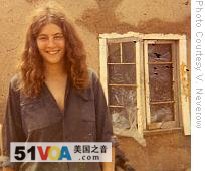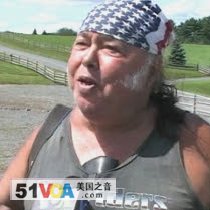New York
14 August 2009
 |
| The crowd in the mud at Woodstock with the stage in the background (source) |
As magical as participants say the three-day Woodstock Festival was, it didn't just appear fully formed on a Bethel, New York cow pasture, back on August 15, 1969.
 |
| Vara Neverow in New York City during her hippie days |
Neverow was especially intrigued by the people themselves, who were, she says "dressed in really unusual ways, or totally undressed, or drugged out to the point where they were incoherent, or having fabulous visions of secondary worlds."
The 30 or so bands scheduled to play during the Woodstock festival represented the cream of the 1960s music culture. Among many other superstars, fans could get their minds blown by Jimi Hendrix, Janis Joplin, Santana, the Indian sitarist Ravi Shankar, and Crosby Stills, Nash and Young, who had only performed together once before.
Hours into the festival, a driving rain began to soak the fields, turning them into a sea of grassy mud. Neverow says the rain and mud were as constant and unavoidable as the music.
"The dirt was everywhere," she says. "It was on the people. It was sucking people down into the muck. It was the signature of Woodstock ultimately that the Earth itself got involved in the celebration!"
 |
| Vara Neverow back at the Hog Farm commune in 1969 |
Although hippies from every state were probably represented at the festival, not all Woodstock attendees came from far away to enjoy themselves. Debbie Fallon, who was 14 years old at the time, lived just down the road. Although her grandparents (perhaps understandably) did not want her to go, Fallon managed to sneak away to the festival on her bicycle.
"It was a big party. That's how I saw it," she said.
 |
| Two hippies at Woodstock (source) |
"It looked like a city full of just kids!," she says with a grin.
Not all locals felt were amused by the gathering. In a clip from the famous documentary film about the festival, dairy farmer Clarence Townsend minced no words.
"It's a disgraceful mess!" he said. "My fields are all cut up. Our second cutting of hay is going. [As for] my cows, the milk truck didn't get here, so the milk had to be thrown out."
Indeed, traffic coming to the site was backed up over 100 kilometers, and, in an ironic twist, many performers had to be flown to the site on Army helicopters. Soldiers and hippies usually found themselves on opposing sides during the Vietnam era.
But "If it wasn't for them, no bands would have gone back and forth," says musician Richie Havens, who performed the festival's opening act. "How could we dislike the soldiers? They opened up the gate for us."
Vara Neverow says that while the musical entertainment was groovy.
"Woodstock was also about community, and connecting with people and kicking back and just really wondering about the world," she says. "People were just very hopeful and happy."
 |
| Ralph Corwin |
"And there was about 200 young ladies frolicking in the water in the nude," he said. "And I said ‘today is going to be a good day!'"
Every day was also a rainy day at Woodstock, a circumstance that was met with resigned good cheer both on stage and off.
Woodstock organizers had planned for only 60,000 attendees. The 300,000 to 400,000 people who showed up severely stretched the festival's food, water and sewage resources.
But attendees like Duke Devlin managed to make the best of things. Devlin is now a paid guide at the new multimillion dollar Woodstock museum about a kilometer down the road.
 |
| Duke Devlin |
But that dreamland could not be sustained. By Sunday, the third and final day of the festival, food and water were running out, and disaster loomed.
"Not that anyone ever behaved badly," says Vara Neverow. "It was all extremely supportive, caring?and incredibly blissful."
Indeed, she recalls that there was a sense of coherence and wholeness - even amid the apparent chaos which she likens to the LSD experience "?where the world is just this extraordinarily beautiful or frightening, chaotic, yet orderly vision?of an alternative world." She compares Woodstock to "falling off a cliff into another universe."
For many attendees, the Woodstock Festival has had a lasting impact. Local resident Ralph Corwin, for example, who came for some free love at the pond, often visits the site today whenever he needs spiritual refreshment and peace of mind.
"This is the only place in the world where nothing bad ever happened to me," says Corwin, who plans to have his ashes scattered on the site. "And maybe in a hundred years they'll still be celebrating [Woodstock], and somebody will walk by, roll me up and smoke me!"
 |
| Vara Neverow in 2009 |
"It was an inspiration I think for people to get back to the land, return to the ‘Garden [of Eden],' change the world, leave the constraints of urban life and do other things," she said.
For her, Woodstock was a was a rip in the fabric of our culture that could not be "repaired." And in her opinion, and in the opinion of millions of others who wish they had been at this signal event, "that is, for the most part, a very, very good thing!"